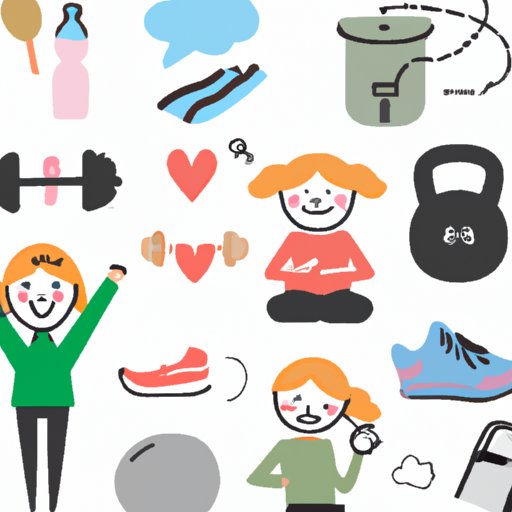Introduction
Physical fitness is an important part of life. It’s defined as the ability to perform daily activities with vigor and alertness, without undue fatigue, and with ample energy to enjoy leisure-time pursuits and respond to emergencies. In other words, it’s the ability to live life to its fullest potential. Achieving physical fitness requires a combination of good nutrition, regular physical activity, and a positive attitude.
Being physically fit means having the strength, endurance, and flexibility to perform daily activities with ease. It also means being able to handle physical challenges, such as running a marathon or lifting heavy objects. Good physical fitness can help you avoid serious health problems, including heart disease, stroke, and diabetes. It can also help you maintain a healthy weight and reduce your risk of developing certain types of cancer.
Benefits of Regular Exercise and Physical Activity
Regular exercise and physical activity have many benefits. According to the Centers for Disease Control and Prevention (CDC), some of these benefits include improved health, increased strength and endurance, and reduced stress and anxiety.
Improved Health
Regular exercise and physical activity can help you stay healthy and prevent chronic diseases like heart disease, cancer, and diabetes. According to the World Health Organization (WHO), physical activity helps reduce the risk of premature death from all causes. Additionally, studies have found that regular physical activity can reduce the risk of depression and anxiety.
Increased Strength and Endurance
Regular exercise and physical activity can help you gain muscle strength and endurance. Studies have found that regular exercise can increase muscle strength by up to 30%, while improving aerobic capacity by up to 20%. Additionally, regular physical activity can help improve balance and coordination, which can help reduce the risk of falls and injuries.
Reduced Stress and Anxiety
Exercise and physical activity can help reduce stress and anxiety by releasing endorphins, which are hormones that act as natural painkillers. Endorphins can also help reduce feelings of depression and anxiety. Furthermore, regular physical activity can help improve sleep quality, which can help reduce stress levels.

How to Develop a Personal Physical Fitness Plan
Developing a personal physical fitness plan can help you reach your fitness goals. Here are three steps to help you create a plan that works for you:
Identifying Goals
The first step in creating a personal physical fitness plan is to identify your goals. Think about what you want to accomplish and why. Do you want to lose weight? Build strength? Increase endurance? Knowing your goals will help you create a plan that works for you.
Creating an Exercise Routine
Once you’ve identified your goals, the next step is to create an exercise routine. This should include both cardiovascular and strength training exercises. Cardiovascular exercises, such as running, biking, and swimming, can help improve your cardiovascular health and burn calories. Strength training exercises, such as weightlifting, can help build muscle and improve strength.
Setting Up a Support System
Finally, it’s important to set up a support system to help you stay on track. Find a friend or family member who can keep you motivated and accountable. Having someone to share your progress with can help you stay focused and committed to your exercise goals.

Exercises and Workouts for Physical Fitness
There are many different types of exercises and workouts that can help you achieve physical fitness. Here are some of the most common:
Cardiovascular Workouts
Cardiovascular workouts, such as running, biking, and swimming, can help improve your cardiovascular health and burn calories. Studies have found that regular aerobic exercise can reduce the risk of heart disease and stroke. Additionally, it can help improve your lung capacity and boost energy levels.
Strength Training
Strength training exercises, such as weightlifting, can help build muscle and improve strength. Studies have found that regular strength training can reduce body fat and increase muscle mass. Additionally, it can help improve balance and coordination.
Flexibility Exercises
Flexibility exercises, such as stretching and yoga, can help improve flexibility and range of motion. Studies have found that regular stretching can reduce injury risk and improve athletic performance. Additionally, it can help reduce stress levels and improve posture.
Nutrition and Physical Fitness
Eating healthy foods is an important part of achieving physical fitness. Eating a balanced diet can help provide your body with the nutrients it needs to perform at its best. Eating healthy foods can also help you maintain a healthy weight and reduce your risk of developing certain types of cancer. Additionally, taking dietary supplements and vitamins can help ensure that you get all the essential nutrients your body needs.

The Mental Health Benefits of Physical Fitness
Physical fitness can also have positive effects on mental health. Studies have found that regular exercise can help improve mood and reduce feelings of depression and anxiety. Additionally, it can help increase self-confidence and lower stress levels. Exercise can also help improve sleep quality, which can further reduce stress levels.
Conclusion
Physical fitness is an important part of life. Regular exercise and physical activity can help improve physical and mental health, reduce stress levels, and increase self-confidence. To achieve physical fitness, it’s important to create a personal plan that includes both cardiovascular and strength training exercises, as well as healthy eating habits. Additionally, it’s important to set up a support system to help you stay motivated and on track. With the right plan and support, you can be on your way to achieving physical fitness and reaping all the benefits it has to offer.
(Note: Is this article not meeting your expectations? Do you have knowledge or insights to share? Unlock new opportunities and expand your reach by joining our authors team. Click Registration to join us and share your expertise with our readers.)
